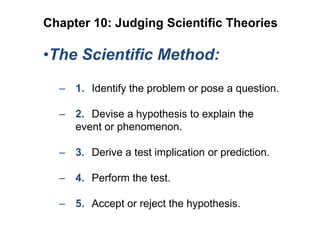
Chapter 10
- 1. Chapter 10: Judging Scientific Theories •The Scientific Method: – 1. Identify the problem or pose a question. – 2. Devise a hypothesis to explain the event or phenomenon. – 3. Derive a test implication or prediction. – 4. Perform the test. – 5. Accept or reject the hypothesis.
- 2. 1. Identify the problem or pose a question • The questions we ask are a reflection of our interests. Science is not disinterested knowledge accumulation – we are interested in significant knowledge. • What makes knowledge significant is that it is knowledge that addresses our interests. • What questions is the theory answering? Why are we seeking knowledge?
- 3. 2. Devise a hypothesis to explain a phenomenon. • Where do hypotheses come from? – Do we collect data and generalize from it – enumerative induction? No! – Hypotheses generally contain theoretical concepts that are not in the observational data. Scientific knowledge is not just generalization from observation. – Hypotheses also must be considered in relation to alternatives – we never just look at one hypothesis in isolation.
- 4. 3. Derive a test implication or prediction. • Typically scientific theories cannot be tested directly (in part because they include theoretical concepts that are not observable). • We indirectly test a scientific hypothesis by deriving observable test implications.
- 5. 4. Perform the test. • If this hypothesis is true, what consequences would follow? If H, then C. Not-C. Therefore not-H. • Deductive logic can disconfirm a hypothesis but not confirm it. (Modus Tollens) • But the process is rarely this simple – remember we are testing hypotheses against each other and not just against the observations.
- 6. 5. Accept or reject the hypothesis • We cannot conclusively confirm a hypothesis (ever). Thus accepting a hypothesis is always provisional. • This does not mean that all hypotheses are equally good (or bad)! We have some (good) reasons to prefer the better hypothesis.
- 7. Review: The Logic of Hypothesis Testing: •The hypothesis disconfirmed— – If H, then C. – not-C. – Therefore, not-H. •The hypothesis confirmed— – If H, then C. – C. – Therefore, H. • This is not a valid deductive argument (affirming the consequent) and so the reasoning here is always provisional (inductive)
- 8. Judging Scientific Theories • Testability: Whether there is some way to determine if the theory is true (or false) • Fruitfulness: The number of novel predictions made • Scope: The diversity of the phenomena explained • Simplicity: The number of assumptions made • Conservatism: How well a theory fits with existing knowledge
- 9. Making Weird Mistakes • Leaping to the weirdest theory: Just because you can’t think of a natural explanation does not mean that there isn’t one. • Mixing what seems with what is: just because something seems real, it is real. (A better principle: It’s reasonable to accept the evidence provided by personal experience only if there’s no good reason to doubt it.) • Misunderstanding the possibilities: confusing logical possibility and physical possibility. Also, believing that if something is logically possible, it must be actual.
- 10. • Common Mistakes in Assessing “Weird” Theories: Believing that just because you can’t think of a natural explanation, a phenomenon must be paranormal. Thinking that just because something seems real, it is real. (A better principle: It’s reasonable to accept the evidence provided by personal experience only if there’s no good reason to doubt it.) Misunderstanding logical possibility and physical possibility. Also, believing that if something is logically possible, it must be actual.